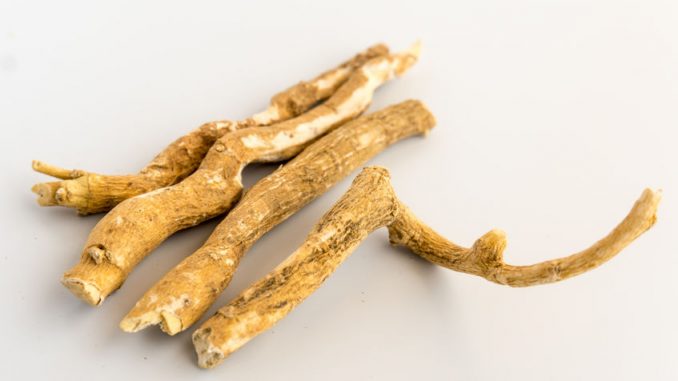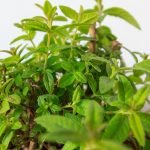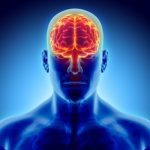
Ashwagandha (Withania somnifera. Dunal) is an adaptogen known primarily for its stress-reducing properties. It’s also known as Indian ginseng, poison gooseberry and winter cherry, a member of the Solanaceae family and is a common herbal in Ayurvedic medicine. The herb is commonly available as a churna, a fine sieved powder that can be mixed with water, ghee (clarified butter) or honey.
A recent upsurge in new product development opportunities has led to interest into an ingredient that induces relaxation (Mishra et al., 2000). The species name hints at its ability to help with restful sleep. There is a growing awareness that ashwagandha demonstrates some promise for health benefits in sports nutrition, aging, cognition and maintaining memory and immune support (Bone, 1996). It is also prescribed in the Ayurvedic medicine system for arthritis (joint health) and rheumatism, as an aphrodisiac, to treat male sexual dysfunction and infertility.
Componentry
The genus Withania includes more than 23 species of herbs with distinct cultivars. Based on chemical composition, Withania somnifera has been classified into different varieties. Steroidal alkaloids and lactones comprise a class of chemicals known as withanolides which predominate in the plant’s roots. These were identified in the mid-50s (Majumdar, 1951) which stimulated interest into the different types available.
Ashwagandha found in Israel contains the components withaferin A, withanolide D and E. The same plant found in South Africa contains mostly withaferin A and a form called D whilst the Indian variety boasts strong levels of withanone and withaferin A. Hybridization has also occurred among these varieties which allows for considerable genetic variation and contents of these various alkaloids.
The aerial parts of Withania somnifera yielded 5-dehydroxy withanolide-R and withasomniferin-A (Atta-ur-Rahman et al., 1991).
Clinical Studies
Stress And Anxiety Reduction
One recent study found that it might be useful in reducing chronic stress which is linked to higher than normal levels of obesity amongst a number of other problematic stress related conditions. Cortisol is a naturally produced steroid generated during types of stress if effective control is feasible, it is possible to manage weight in part by controlling its production in the body.
Weight Management
One clinical study from India ascribed regular use of Ashwaganda to improved scores in a series of rating assessments -the Perceived Stress Scale and Food Cravings Questionnaire, Oxford Happiness Questionnaire, and Three-Factor Eating Questionnaire. The herb also positively affected serum cortisol, body weight and body mass index (BMI) (Choudhary et al., 2017).
Muscle Mass And Strength Improvement
Human trials also indicated the herb might help sportsmen and women by benefitting those undergoing resistance training when increasing muscle mass and strength (Wankhede et al., 2015).
Joint Pain
One of the most debilitating conditions is osteoarthritis which is a highly painful inflammation of the joint especially of the hips and knees. The only secure method of treatment is to use nonsteroidal anti-inflammatory drugs (NSAIDS) such as ibuprofen and to a lesser extent paracetamol. Many of the powerful drugs cause considerable issues with the gastrointestinal tract.
Ashwagandha has been shown in previous studies with other nutraceuticals to help alleviate the pain of osteoarthritis. A recent study published in the Journal of Ayurvedic and Integrative Medicine assessed the performance of a standardized extract of W. somnifera in treating knee pain. This was a double-blind, placebo-controlled trial involving 60 patients with knee pain. Subjects were randomised by taking capsules of W. somnifera at a dosage of 500mg per day, 250mg per day, or the placebo for 12 weeks. Each capsule contained standardised aqueous extract of roots and leaves (Sensoril®) (Ramakanth et al., 2016).
Any analgesic therapy was stopped between 7 and 10 days before the study started and their osteoarthritic symptoms were assessed at baseline, 4, 8 and 12 weeks. The main measure of osteoarthritis used was a percentage change in the Modified Western Ontario and McMaster University Osteoarthritis index (mWOMAC) after 12 weeks.
All subjects showed similar baseline measures for the mWOMAC. After 12 weeks there was a noticeable improvement in the score the higher dosage. The values at 12 weeks were 15.45 (high-dose group); 6.5 (low-dose group) and 2.15 (placebo group). Furthermore, the high-dose group improved most rapidly with these changes being perceived as early as four weeks following the start of the trial.
The key findings as far as joint pain are concerned showed that ashwagandha has effective analgesic, anti-inflammatory and chondroprotective properties. The componentry is thought to block the cyclo-oxygenase pathway which produces prostaglandins. It is feasible that a standardised dose of 500mg W. somnifera extract could be an effective NSAID.
Sales & Marketing
The plant has been included in the list of the top thirty-two medicinal plants of prime concern by the National Medicinal Plant Board of India (http://www.nmpb.nic.in) owing to its huge demand in both domestic and international markets (Prajapati, 2003).Regardless of the variety on sale, growth is observed in the marketplace for the herb. Between January 2015 and January 2016, overall U.S. sales of products containing ashwagandha rose by 63 percent, reaching more than US$13 million in sales by the end of 2016, according to SPINS scan data. Innova Market Insights reported an 18% average annual growth for new product launches featuring the herb as an ingredient (Global, CAGR 2013-2017).
In 2017, 59% of all new product launches tracked with ashwagandha as an ingredient are supplements, whereas 13% of all new product launches tracked with ashwagandha are soft drinks, compared with just 4% in 2013.
In 2017, 49% of all new product launches reported with ashwagandha as an ingredient featured an energy claim.
As a powerful contributor of healing and wellness, ashwagandha’s adaptogenic and whole-body approach promotes an overall feeling of well-being regardless of the health concern it’s being used to support. In light of its myriad uses, and comparability to other pharmaceuticals on the market that offer similar benefits, an increasing number of studies and clinical trials are showing ashwagandha adds to any holistic or nutraceutical supplement or regimen. It may be a very interesting component for any herbal drink marketed at inducing sleep or improving overall fitness.
Sadly, over collecting may have put the plant on the verge of extinction. There is a great deal of interest in cell culturing the plant.
Legal Disclaimer Concerning Products On This Web-Site
The products and the information provided about specific products on or through this site have not been evaluated by the United States Food and Drug Administration or by any other national regulatory body and are not intended to diagnose, treat, cure or prevent disease. The information provided on this site is for informational purposes only and is not intended as a substitute for advice from your physician/doctor or other health care professional or any information contained on or in any product label or packaging. You should not use the information on this site for diagnosis or treatment of any health problems or for prescription of any medication or other treatment. You should consult with a healthcare professional before starting any diet, exercise or supplementation program, before taking any medication or if you suspect you might have a health problem.
References
Atta-ur-Rahman, Samina-Abbas, Dur-e-Shahwar, Jamal, S.A., Choudhary, M.I. and Abbas. S. (1991). New withanolides from Withania spp.. J. Natural Products 56 pp. 1000–1006.
Bone, K. (1996) Clinical Applications of Ayurvedic and Chinese Herbs. Monographs for the Western Herbal Practitioner. Australia: Phytotherapy Press. Pp. 137-141
Choudhary, D., Bhattacharyya, S. & Joshi, K. (2016) Body Weight Management in Adults Under Chronic Stress Through Treatment With Ashwagandha Root Extract. A Double-Blind, Randomized, Placebo-Controlled Trial. J. Evid. Based Complementary Altern. Med. 22(1) pp. 96-106
Majumdar, D.N. (1955) Withania somnifera Dunal. Part II: alkaloidal constituents and their chemical characterization. Ind. J. Pharm. 17 pp. 158-161
Mishra, L.C., Singh, B.B., Dagenais, S. (2000) Scientific basis for the therapeutic use of Withania somnifera (ashwagandha): a review. Alternative Medicine Review. 5 pp. 334–46.
Prajapati, N.D., Purohit, S.S., Arun, K.S., and Kumar ,A, T. (2003) Hand Book of Medicinal Plants, A Complete Source Book. Jodhpur, Agrobios, India.
Ramakanth, G.S., Uday Kumar, C., Kishan, P.V., Usharani, P. (2016) A randomized, double blind placebo controlled study of efficacy and tolerability of Withaina somnifera extracts in knee joint pain. J. Ayurveda Integr. Med. 7(3) pp. 151-157 https://www.ncbi.nlm.nih.gov/pubmed/27647541
Verma, S. K., & Kumar, A. (2011). Therapeutic uses of Withania somnifera (Ashwagandha) with a note on withanolides and its pharmacological actions. Asian Journal of Pharmaceutical and Clinical Research, 4(1), pp. 1-4
Wankhese, S., Langade, D., Joshi, K., Sinha, S.R., Bhattacharyya, S. (2015) Examining the effect of Withania somnifera supplementation on muscle strength and recovery: a randomized controlled trial. J. Int. Soc. Sports Nutr. Nov 25 pp. 12:43


Leave a Reply